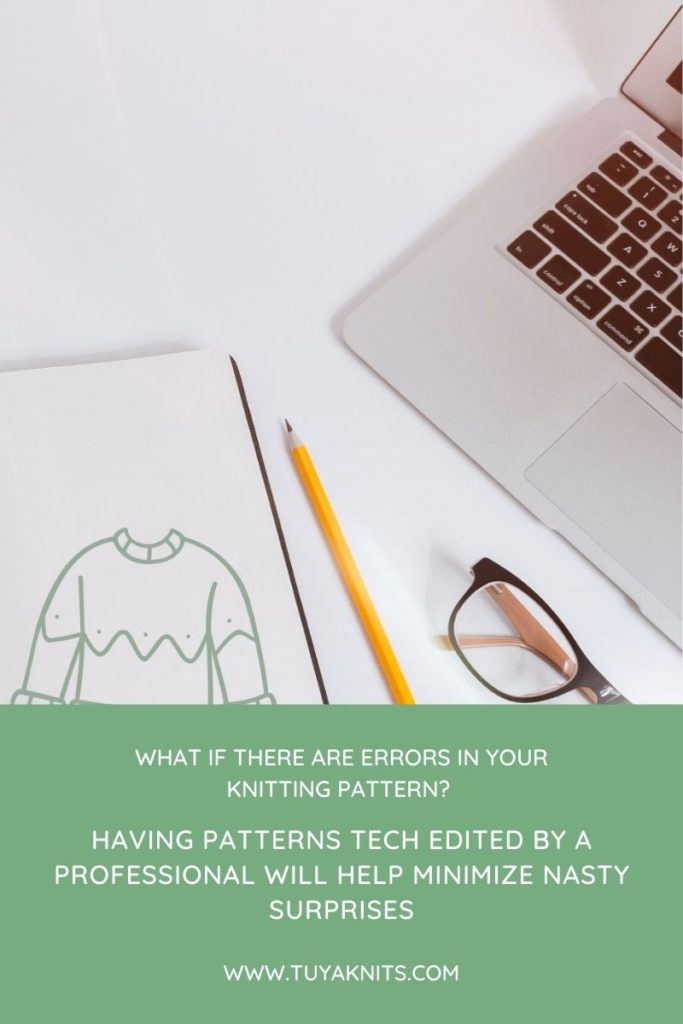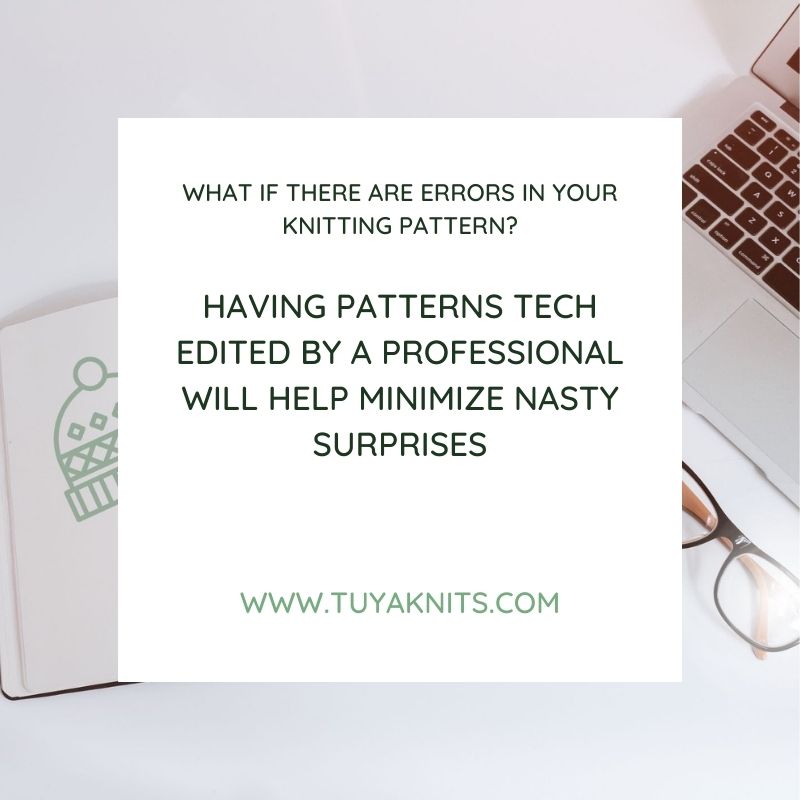Myös saatavilla|Also available in: Suomi (Finnish)
Yes, I agree. Hiring a technical editor is an investment. It’s a significant investment for an independent knit designer, and even more so for someone who is just taking their first steps as a designer and looking for their audience. However, it’s worth investing in quality, as it affects, from your first patterns how knitters view them and what reputation you gain as a knit designer.
What does the technical editing of a knitting pattern mean?
Let’s start with the basics. Technical editing of a knitting pattern, ie. tech editing or simply checking a knitting pattern – a dear child has many names – means that a hired professional will thoroughly check the knitting pattern before it is published. During the technical editing, for example the following details are checked:
- the accuracy of stitch counts in all stages of the pattern
- the accuracy of row / round counts at different stages of the pattern (if given)
- accuracy of charts
- do the charts work with the given stitch and row / round counts?
- do the charts and corresponding written instructions match with each other (if written instructions are provided)?
- spelling
- consistent use of terms and abbreviations
- consistency of instructions
- logic and structure of the pattern
- garment measurements
- schematics
- do images match with the pattern?
- yarn consumption in all sizes
As the list shows, there are many different steps and details involved in creating a knitting pattern that need to be considered. So, it is no wonder that mistakes are easily made at different stages of the process!
The designers kind of look too closely at their patterns and see the content as it is in their minds. But we are all human beings and mistakes happen. That is part of it all. With a couple of years of tech editing experience, I will share a secret 😉: so far, no completely error-free knitting patterns have ended up on my desk!
What is the significance of tech editing a knitting pattern?
From my point of view, the fundamental importance of checking knitting patterns is to support knitwear designers in producing knitting patterns that
- are well written and consistent
- contain all the necessary information
- are easy to follow
- are faultless and
- are a pleasure to knit.
The tech editor thus acts as an extra pair of eyes and a helper for the designer, going through the entire pattern, ensuring that everything is in order and giving the designer useful tips and support as needed.
From the perspective of a knit designer, one might think that a knitting pattern tech edited by a professional is a service and a guarantee of quality in the direction of the knitter. The fact that the knitting pattern has been checked is also likely to reduce the time and energy that the designer must spend on pattern support after the pattern is published.
Couldn’t errors be identified by organizing a test knit?
What should you think about organizing a test knit in this context? After all, there are plenty of enthusiastic knitters who will be happy to help the designer with the sheer joy of knitting! Many are also attracted by the opportunity to be among the first to knit a new knitting pattern. Even small compensation, for example in the form of a free pattern, can be gratifying.
Ideally, your pattern will have no problems with it and the test knitting will go smoothly. But what would you do if there were clear mistakes in the pattern? What if testers were frustrated waiting for a solution to a problem from you? And would you possibly gain a reputation as an inexperienced or unreliable knit designer?
Test knitting has an important place in testing a pattern and putting it into working condition, but the cumbersome pattern checking process cannot and should not be imposed on volunteer test knitters. Each of the knitters usually knits only one size and considers the pattern from that one-size perspective. Also, knitters working for free cannot be expected to look at the pattern as a whole from every single perspective.
Test knitters also may not have knowledge of what is essential to give feedback to the designer. Or even if the knitter has a solid idea of the matter, how many dare to take the position of authority and comment on just about anything?
Another chapter in itself is that different knitters may have different, even conflicting views on things, and the designer may find the situation difficult. Should everyone be pleased and who in the final games will decide how to write the pattern?
What do long-line knitting professionals have to say?
Some experienced knitwear designers and tech editors have looked into the reasoning behind tech editing of indie patterns. They have written in their blog about whether individually published knitting instructions are worth tech editing, and have excellent perspectives.
Irish knitwear designer Carol Feller has written about the difference between a tech editor and a test knitter and has a view on what to expect from one or the other:
“Typically they [test knitters] are not paid, although sometimes patterns, yarn and discounts are given in exchange. There are no binding contracts as it is not a professional relationship. This means that if they run out of time or change their mind there isn’t much you can do about it as they are knitting it for pleasure rather than obligation. When you hire an editor however you’re paying for professional services which means that doing the job right is as important to them as to you as their reputation is also on the line from the work they produce.”
Carol Feller
British designer Sister Mountain has written a comprehensive blog post called A Beginners Guide to Working with Tech Editors. She analyzes tech editing in general, the difference between tech editing and test knitting, and has a say on tech editing one’s own patterns, too:
“You should never attempt to tech edit your own patterns. Even tech editors who design don’t do that! You are too close to the pattern and won’t spot all of the errors or clarity issues. It is worth getting a second pair of eyes on it.”
Sister Mountain
And finally, Joeli Kelly, the creator of the technical editing course attended by many of us tech editors – me included! – has provided a practical example of how the same instructions can be written in different ways and with different accuracy:
“Take a look at the following “patterns”:
Version 1: Cast on 100 stitches. Rnd 1: K2, p2 to end. Round 2: Knit. Continue this way until work measures 60 inches. CO all sts.
Version 2: Cast on 100 stitches. Join to work in the round, being careful not to twist stitches. Rnd 1: *K2, p2; repeat from * to end. Rnd 2: Knit. Repeat Rnds 1 & 2 until work measures 60″ / 152.5 cm from cast on or until desired length for scarf. Cast off all stitches.The first could have very well made it through test knitting, but no good tech editor would let it go like that. They would guide a designer to something much more like the second which is clearer, more consistent in style, and least likely to cause problems for the knitter. That’s why a designer hires a tech editor.”
Joeli Kelly
Do you notice any significant differences between the different versions? Which is more accurate and consistent? Is the first version missing relevant information and what could they be? Are there any direct errors?
Of course, it is always up to the knitting designer to decide whether or not to use the services of a technical editor. However, I hope that this text has given food for thought to decision-making.
FURTHER READING: 3 REASONS WHY A STYLE GUIDE IS A VALUABLE TOOL FOR INDIE DESIGNERS


Be the first to comment